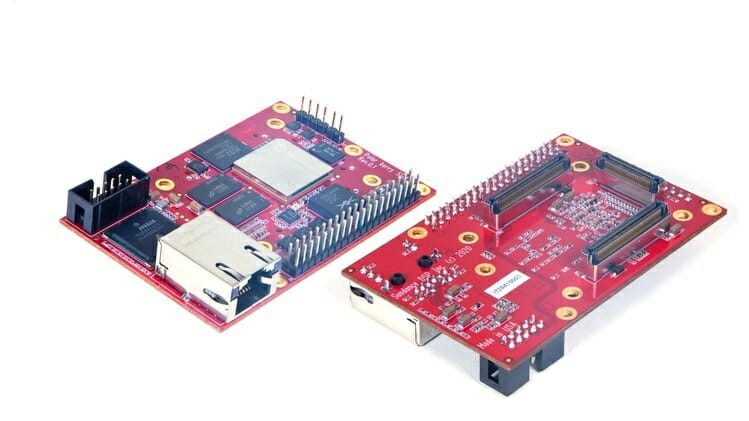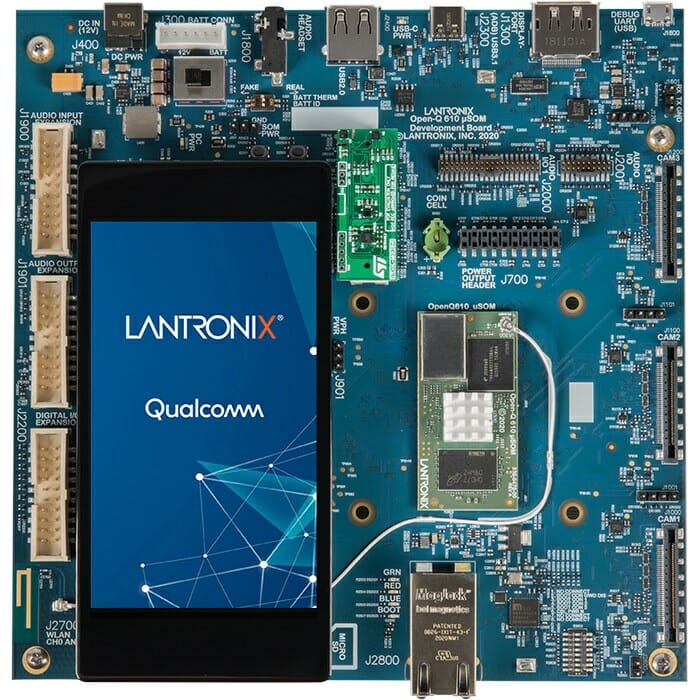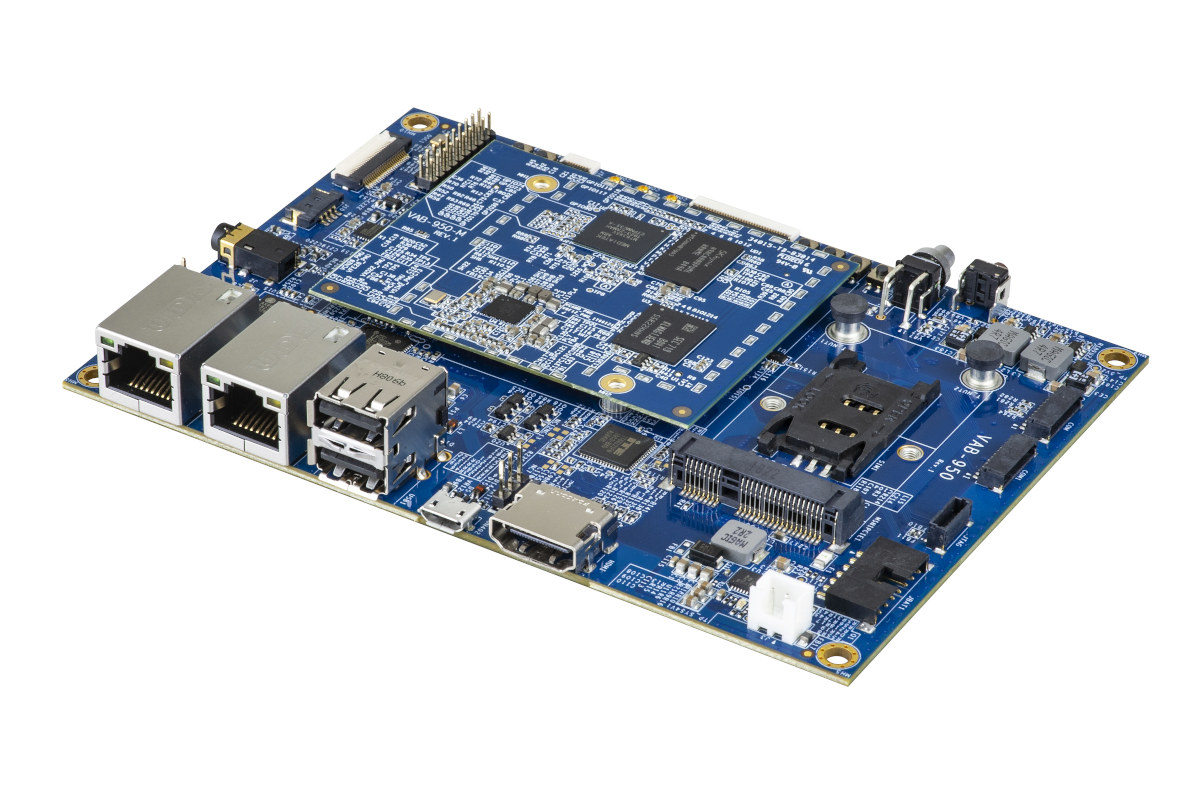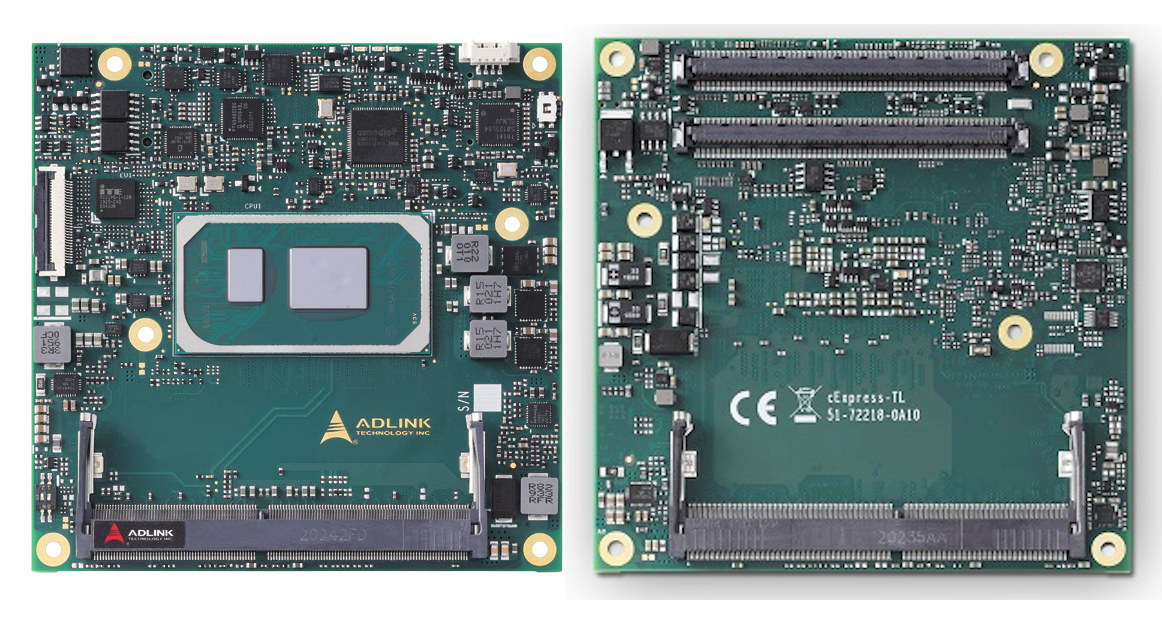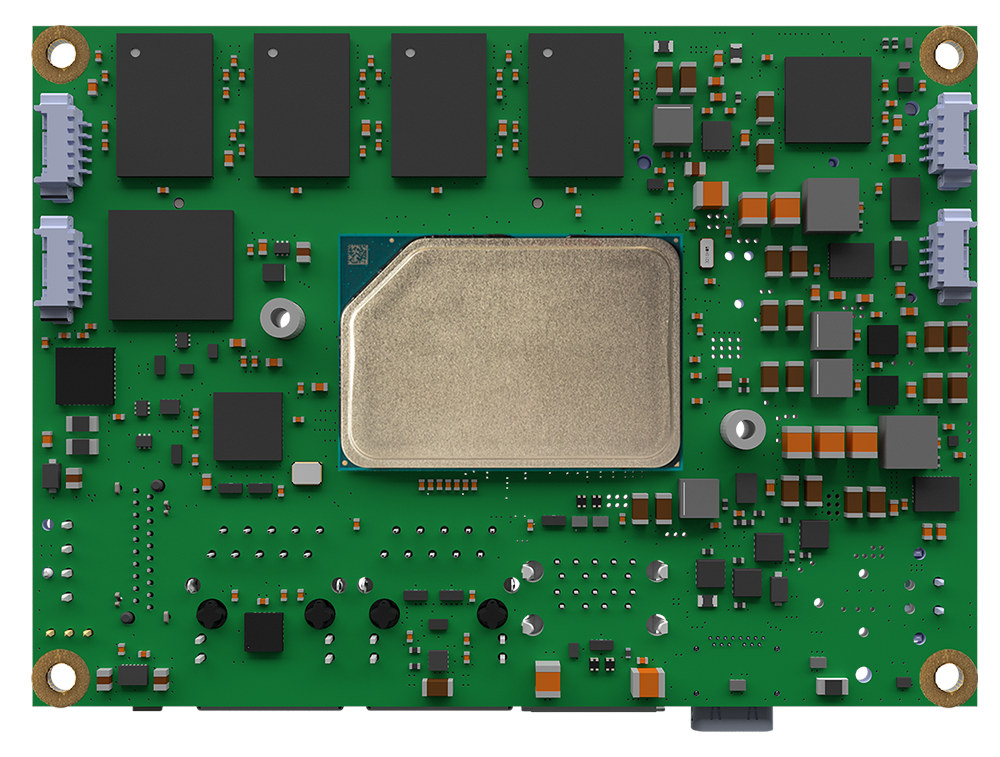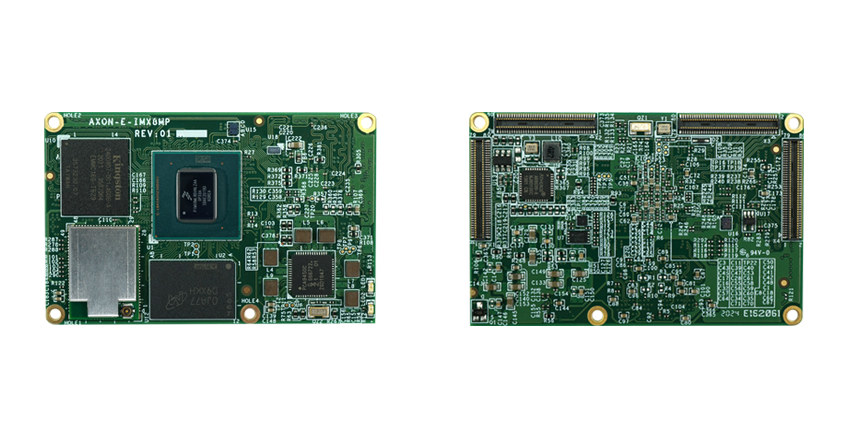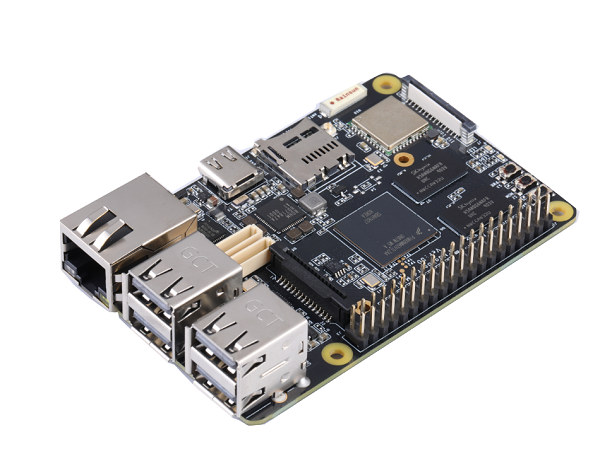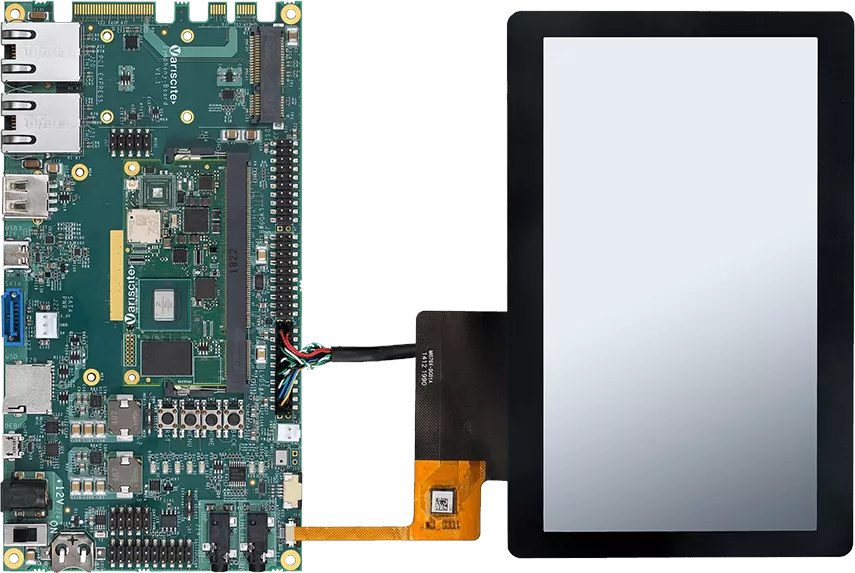SiFive may just have announced a mini-ITX motherboard for RISC-V PCs, but if you’d like a RISC-V Linux platform in a more compact form factor, Sundance PolarBerry may better fit your requirements, albeit the board will target different use cases. Powered by Microchip PolarFire RISC-V SoC FPGA, PolarBerry is both a single board computer with Gigabit Ethernet and 40-pin GPIO header, as well as a system-on-module thanks to three Samtec board-to-board connectors. PolarBerry specifications: SoC – Microsemi PolarFire FPGA MPFS250T-FCVG484 penta-core processor with 1x RV64IMAC monitor core, 4x RV64GC application cores, FPGA fabric with 254K x logic elements (4LUT + DFF), 784 x math blocks (18 x 18 MACC), and 16 x SERDES lanes at 12.5 Gbps; 12 W maximum power consumption System Memory – 4 GB of 32-bit wide DDR4 memory Storage – 4GB eMMC flash, 128 Mbit SPI Serial NOR flash for boot image Networking – Gigabit Ethernet […]
Qualcomm QCS610 micro SoM and devkit to power AI and ML smart cameras
Last July, we missed Qualcomm’s announcement of QCS410 and QCS610 processors designed to bring “premium camera technology, including powerful artificial intelligence and machine learning features formerly only available to high-end devices, into mid-tier camera segments”. The new SoC’s were recently brought to our attention by Lantronix as they have just introduced a new Open-Q 610 micro system-on-module (μSOM) based on Qualcomm QCS610 processor, as well as a development kit designed to bring such smart cameras to market. I first got a bit confused by the product name, but this goes without saying that it is completely unrelated to Qualcomm Snapdragon 610 announced over six years ago. Open-Q 610 micro system-on-module Open-Q 610 specifications: SoC – Qualcomm QCS610 CPU – Octa-core processor with 2x Kryo 460 Gold cores @ 2.2 GHz (Cortex-A76 class), and 6x Kryo 430 Silver low-power cores @ 1.8GHz (Cortex-A55 class) GPU – Qualcomm Adreno 612 GPU @ […]
VIA VAB-950 SBC Features MediaTek i500 SoC for AIoT Applications
While MediaTek is better known for their mobile SoCs and they also offers processors made for AIoT (AI + IoT) applications such as MediaTek i700, i500 or i300 SoCs. We only covered a few development / evaluation boards so far, with Pumpkin i500 SBC or Innocom SB30 EVK, but we’ve now got another one with VIA VAB-950 single board computer equipped with MediaTek i500 AIoT octa-core processor, up to 4GB LPDDR4, 16GB flash storage, HDMI, dual Fast Ethernet, dual-band 802.11ac Wi-Fi, Bluetooth 5.0, and support for 4G LTE cellular connectivity. VAB-950 SBC specifications: SOM-9X50 system-on-module SoC – MediaTek i500 octa-core processor with 4x Cortex-A73 @ 2.0GHz, 4x Cortex-A53 @ 2.0GHz Arm Mali-G72 GPU up to 800 MHz with support for OpenGL ES 3.0, OpenCL ES 1.1, and Vulkan 1.0 VPU for 1080p30 H.264/H.265 decoding 2x Cadence Tensilica Vision P6 DSPs System Memory – 2GB or 4GB LPDDR4 SDRAM Storage – […]
Intel Tiger Lake UP3 COM Express Module Offers High AI Performance, PCIe Gen4 Interface
Earlier today, Intel announced the Elkhart Lake IoT edge processor family, and as well as more 15W Tiger Lake Core i3/i5/i7 UP3 processors designed for IoT & embedded applications, and with a configurable TDP from 12W to 28W. ADLINK Technology is leveraging existing and those new Tiger Lake UP3 processors with the cExpress-TL COM Express Type 6 module based on the various Intel Core i7/i5/i3 and Celeron Tiger Lake UP3 SKUs delivering three times the AI inferencing performance of older platforms thanks to AVX-512 Vector Neural Network Instructions (AVX512 VNNI) instructions and equipped with the latest PCIe Gen4 expansion interface. cExpress-TL COM Express Tiger Lake module specifications: SoC (one or the other) Intel Core i7-1185G7E quad-core/octa-thread processor with 12MB cache, Intel Iris Xe graphics with 96x EU; up to 28W TDP (cTDP 15W) Intel Core i5-1145G7E quad-core/octa-thread processor with 8MB cache, Intel Iris Xe graphics with 80x EU; up to […]
Congatec Unveils Atom x6000E Elkhart Lake Powered Pico-ITX SBC, Qseven, SMARC, COM Express Modules
With the announcement of Intel Elkhart Lake IoT-optimized processors, we should expect embedded systems companies to unveil their own Atom x6000E and Celeron/Pentium Elkhart Lake powered products, and one of the first to do so is Congatec with the introduction of four different Elkhart Lake computers-on-module (CoM) following Qseven, SMARC, and COM Express standards, as well as a Pico-ITX SBC. conga-PA7 Atom x6000E SBC (with Celeron/Pentium J optional) Detailed specifications: SoC – Choice of eight different Elkhart Lake processors from the 6W Atom x6211E dual-core processor to the 10W Intel Pentium J6425 quad-core processor up to 3.0 GHz, all with 10th Gen Intel UHD graphics System Memory – Up to 16GB quad-channel onboard LPDDR4x Storage 32GB or 64GB UFS 2.0 flash (optional up to 512GB) M.2 SATA/PCIe SSD support (see expansion) 32 MB serial flash for AMI Aptio UEFI firmware Video DisplayPort DP++ video output up to 4Kp60 1x USB-C […]
TechNexion Unveils EDM and AXON SoM’s Powered by NXP i.MX8M Plus SoC
A few days ago we wrote about Variscite’s NXP i.MX 8M Plus-powered AI systems-on-modules and devkits, and now it’s TechNexion’s turn to introduce its own SoM’s for artificial intelligence applications. Just like variscite, the company has two variants with EDM-G-IMX8M-PLUS following the EDM standard with a 260-pin edge connector, and AXON-E-IMX8M-PLUS part of the AXON family with board-to-board connectors better suited to vibration-prone applications. Besides the form factor and different default storage capacities, both SoM’s share the same specifications: SoC – NXP i.MX8M Plus quad-core Cortex-A53 processor @ up to 1.8 GHz with Cortex-M7 real-time core @ 400 MHz, Vivante GC520L 2D GPU, Vivante GC7000UL 3D GPU, 1080p60 hardware decoder (HEVC, H.264, VP9, and VP8) and encode (H.265/H.264), and 2.3 TOPS NPU System Memory – Up to 8 GB LPDDR4 Storage AXON-E-IMX8M-PLUS – 32 GB eMMC flash by default EDM-G-IMX8M-PLUS – 16 GB eMMC flash by default Networking Chips Qualcomm […]
Raspberry Pi inspired MaaxBoard Mini SBC features NXP i.MX 8M Mini SoC
Last year, Embest – an Avnet company – introduced MaaXBoard NXP i.MX 8M SBC mostly compatible with Raspberry Pi form factor and running Android 9.0 or Yocto Linux. The company has now launched MaaXBoard Mini with a 14nm NXP i.MX 8M Mini quad-core processor. In some ways, the new board follows more closely Raspberry Pi 3 Model B form factor with four USB 2.0 ports, instead of the two USB 3.0 ports found in the first version of the board, but it does so without HDMI output, leaving MIPI DSI as the only option for display output. MaaxBoard Mini (AES-MC-SBC-IMX8MINI-G) specifications: SoC – NXP i.MX 8M Mini Quad with 4x Arm Cortex-A53 cores @ up to 1.8GHz, Cortex-M4F real-time core @ 400MHz, Vivante GCNanoUltra 3D GPU and GC320 2D graphics, 1080p H.264/H.265 VPU; System Memory – 2GB DDR4 Storage – eMMC socket for up to 64GB flash, MicroSD slot Display […]
NXP i.MX 8M Plus AI Systems-on-Modules and Devkits Launched by Variscite
NXP i.MX 8M Plus processor was unveiled at the very beginning of the year as the first i.MX processor with AI hardware acceleration provided by a 2.3 TOPS Neural Processing Unit (NPU) embedded in the chip. Apart from the upcoming Wandboard 8MPLUS SBC, we had not seen hardware powered by the new processor, but Variscite has now announced two NXP i.MX 8M Plus systems-on-modules – VAR-SOM-MX8M-PLUS and DART-MX8M-PLUS – and corresponding development kits. VAR-SOM-MX8M-PLUS CPU Module & Development Kit Specifications: SoC – NXP i.MX 8M Plus single, dual or quad-core Cortex-A53 processor clocked at up to 1.6 (Industrial/Extended) or 1.8GHz (Commercial), Cortex-M7 real-time core @ 800 MHz, 1080p H265/H264 encode/decode, AI/ML acceleration up to 2.3 TOPS, GC7000UL 3D GPU, GC520L 2D GPU System Memory – 1 to 4GB LPDDR4 Storage – 8 to 64GB eMMC flash Networking – 802.11 ac/a/b/g/n + BT 4.2/BLE module SO-DIMM Edge Connector Storage I/F – […]


